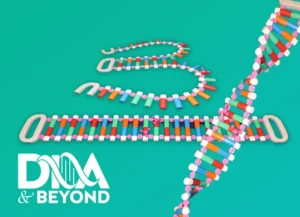Our dynamic DNA model has 21 rungs, with each rung functioning as the smallest unit of DNA’s code. Those, in turn, contain a pair of small molecular units called bases. Each duo of bases functions as a single “letter”. Out of these letters, meaningful messages can be formed.
Our model only represents a short snippet of DNA. It is a 3-D visualization of what a single, extremely short gene could look like. In reality, most genes are significantly longer than that. To reach the length of a typical short gene in a human cell, with about 1000 rungs, one would need to lay out 50 of our models, end to end. The finished product would stretch from the goal line to the 50-yard line of a football field (or from the goal to the midline of a soccer field.) For one of the longest known genes, the titin gene (used to build a gargantuan spring- like protein in muscle cells), one would need to line up over five thousand of our models! With each model being about three feet in length, we would end up with a three miles long model for one titin gene.
With that in mind, let’s now put into perspective the total package of DNA inside the nucleus of a single human cell, which contains approximately 6.4 billion rungs. To match this, one would need over 300 million of our models! If one were to lay them out snugly row by row, even a football field couldn’t contain them – not unless they were stacked on top of each other, each layer covering the field completely, up to 700 feet high.


